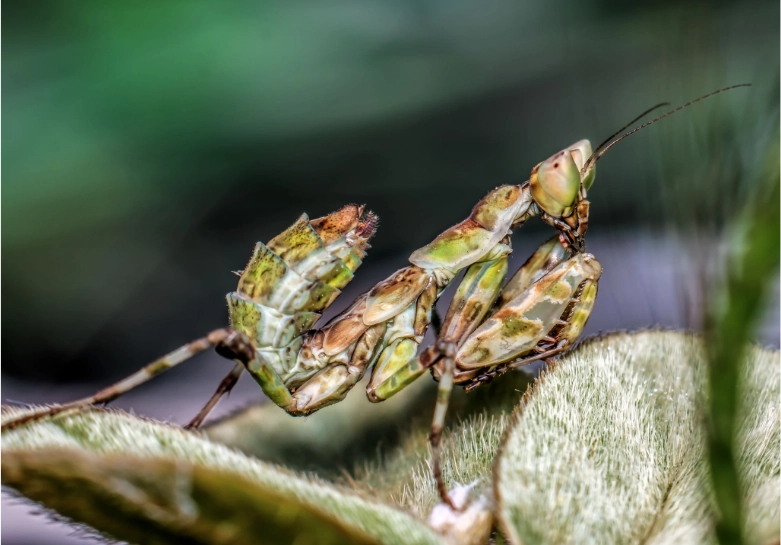The short answer to this question is yes, praying mantises do eat spiders. But that’s not all they eat. Praying Mantises are known to have pretty ravenous appetites, preying on many types of insects, vertebrates, and animals that happen to be within their reach when their hunger starts to kick in.
They’re also known to prey on their own species: larger mantises tend to prey on younger mantises, and female mantises commonly indulge in sexual cannibalism—yes, you read that right.
Want to learn more about these fascinating insects and their eccentric eating habits? Read on.
Praying Mantis: The Basics
A praying mantis is a type of insect that is typically stick-thin and green. According to National Geographic, praying mantises can grow up to six inches in length, but that being said, you’ll usually find praying mantises to be around two to three inches long.
Praying mantises are often associated with grasshoppers, due to their proximity in appearance, coupled with the fact that mantises come from the grasshopper family. However, praying mantises are distinguishable from grasshoppers.
A praying mantis typically stands upright with its arms folded inwards, which can be likened to a praying position. In fact, it is because of this position that mantises are commonly called ‘praying’ mantises.
Praying mantises are an interesting species for a number of reasons. Here are a few fun facts about them:
- They can camouflage themselves (e.g. by pretending to be a leaf in the wind)
- They have 3D vision
- They can turn their heads 180 degrees without moving their bodies (and they’re the only insect capable of doing so!)
- They have ultrasonic hearing— even though they have only 1 ear (that’s located on their stomach)
- They only eat live organisms
- They can fly at night and avoid predators with their ultrasonic hearing
- They eat everything from their own species to spiders and even small birds.
What Does A Praying Mantis Prey On?
Perhaps the most intriguing thing about praying mantises is their eating habits. Ever wondered what constitutes a balanced meal for a praying mantis? Well, the answer may surprise you.
Despite their small size, praying mantises are known to have quite versatile appetites, preying on everything from flies and ants, to much bigger invertebrates such as spiders. They are ambush predators, which means they eat anything that is within their reach.
Here is a list of just some of praying mantises’ favorite foods:
- Insects (such as beetles, mosquitoes, crickets, and grasshoppers)
- Flies; moths
- Smaller praying mantis
- Spiders (including garden spiders, black widow spiders, and other venomous spiders)
- Frogs
- Lizards
- Small birds
While this list is not exhaustive, it is a surprising one. Not only do praying mantis eat organisms much bigger than them, but they also eat venomous spiders without issue.
Praying Mantis vs. Spider: A Complicated Relationship
So, do praying mantis eat spiders? Yes. Do praying mantis eat large spiders that are bigger than them? Yes.
Oftentimes, people wonder in a fight involving a praying mantis vs spider who would win? While the answer may seem clear now, it depends on the type of spider. While praying mantis do prey on various types of spiders, some spiders are also known to prey on mantis. Let’s take a look at some of them.
Do praying mantis eat garden spiders?
Yes! Praying mantis will gladly devour garden spiders. In fact, this is one of the reasons why many people opt to keep praying mantis as pets.
Do praying mantis eat wolf spiders?
Yes! However, wolf spiders are also known to prey on praying mantis. Depending on their size, the bigger organism is usually the predator.
Do praying mantis eat jumping spiders?
Yes, but jumping spiders also eat praying mantis. In fact, the two organisms have quite a similar diet, feeding on small insects, such as crickets, beetles, and caterpillars.
In conclusion, the relationship between praying mantis and spiders is a complicated one. Praying mantis can prey on spiders that are larger than them, while on the other hand, only larger spiders are likely to feed on preying mantis.
How Does A Praying Mantis Catch Its Food?
Praying mantis are gifted in their senses, their ability to camouflage themselves, and in their agility. This makes them unrelenting and fierce predators. Because of their unique ability to turn their heads 180 degrees from one side to the other, their field of vision is quite large, and so they are able to examine their surroundings for prey.
Once the mantis’s prey is within its reach, the mantis will pull another 180 degrees—this time not with its head, but with its speed. From being very still so as to not expose its predatory intentions on its prey, the mantis will suddenly strike with great speed, ambushing its prey and capturing it with its front legs.
In fact, the speed with which mantis strike their prey is so fast, that it is usually not observable by the naked eye.
Once the mantis has secured its prey, it uses its spiked legs to pierce it. No poison needed. Moreover, some mantis have larger guts, which enables them to store their prey inside them and eat it later.
Sexual Cannibalism in Praying Mantis
There are a number of different organisms that are known to indulge in sexual cannibalism, one of them being the praying mantis. This means that after, or often during, mating with a male mantis, the female mantis bites the male mantis’s head off and eat the rest of its body. Afterwards, the female uses the male’s sperm to fertilize her eggs.
While this is not always the case among mating mantis, research shows that it occurs 13-28% of the time during breeding.
According to The Guardian, scientists have concluded that this type of mating behavior results in higher production of eggs. Moreover, it is suggested that the female mantis’s consumption of the male’s body after mating also contributes to the production of eggs, along with the male’s sperm.
Despite this tendency, male praying mantis are not discouraged to mate with their female counterparts. And of course, their mating habit is not the only reason why a praying mantis might die early in captivity.
To conclude, it’s a given that praying mantis are one of the world’s most fascinating insects. From their eating habits to their breeding habits, these creatures are truly unique.
References
- National Geographic – https://www.nationalgeographic.com/animals/invertebrates/p/praying-mantis/
- Science Mag – https://www.sciencemag.org/news/2018/02/world-s-tiniest-3d-glasses-reveal-how-praying-mantises-see-world#:~:text=Praying%20mantises%20are%20the%20only,when%20the%20prey%20is%20moving.
- The Journal of the Acoustical Society of America – https://asa.scitation.org/doi/abs/10.1121/1.2029701#:~:text=Praying%20mantises%20have%20sensitive%20ultrasonic,a%20tightly%20adherent%20tracheal%20sac.
- The Royal Society Publishing – https://royalsocietypublishing.org/doi/full/10.1098/rspb.2016.0656
- The Guardian – https://www.theguardian.com/science/2016/jun/29/having-your-partner-for-dinner-praying-mantis-cannibalism-boosts-fertility-study


